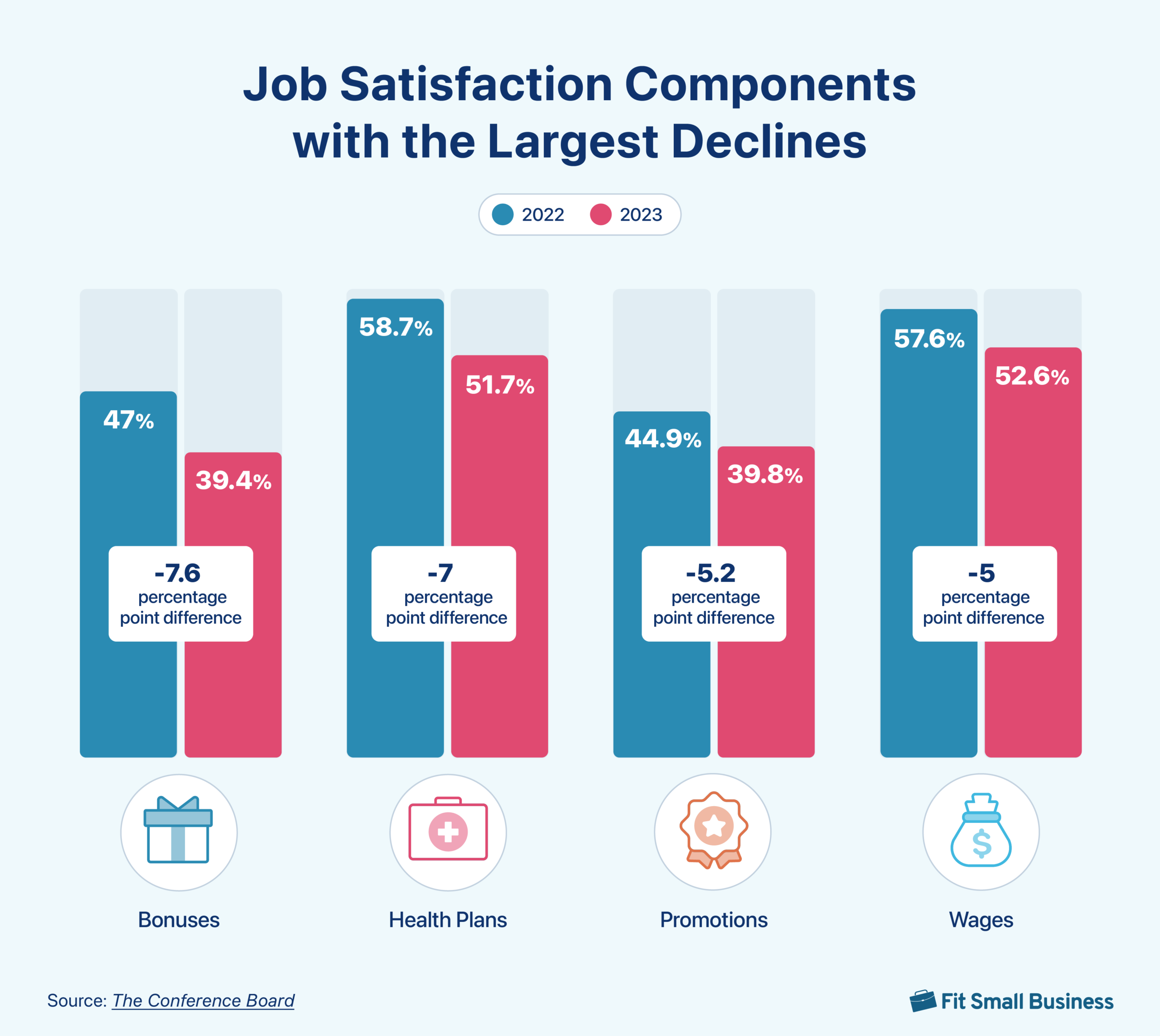Employees who are satisfied with their jobs are more productive and less likely to look for work opportunities that may offer higher pay, competitive benefits, and a career path that helps them grow. While several factors can impact worker happiness, these 19 job satisfaction statistics will help you understand which ones can aid you in attracting and retaining top talents.

General Job Satisfaction Statistics
1.) 62.7% of US workers were satisfied with their jobs in 2023, but overall satisfaction may have plateaued
More than half of American workers expressed satisfaction with their jobs overall, according to the Conference Board’s Job Satisfaction Survey. While this is the highest score recorded since the survey was first started, the happiness level only rose a modest 0.4 percentage points—from 62.3% in 2022 to 62.7% in 2023. This hints that the overall job satisfaction rate may have plateaued after 13 years of this survey posting consistent increases for this metric.
(The Conference Board, 2024)
2.) Overall job satisfaction remains high, but US workers are less content with their bonuses and health plans
As mentioned in the above statistic, overall job satisfaction remains high, but when respondents were asked to rate 26 components or drivers of job satisfaction, all of these showed dips of 0.2 to 7.6 percentage points. Worker contentment with bonuses, health plans, promotions, and wages saw the biggest declines. This suggests that inflation and the rising cost of living may have affected worker sentiment on the salaries and financial benefits they receive.

While pay and core benefits are important to employees, to help prevent declining work satisfaction rates, you should also focus on improving or maintaining other key drivers. These include the quality of office equipment, work environment, and employee experience, such as how workers interact with their colleagues and supervisors—factors that workers considered vital to job happiness in 2023.
(The Conference Board, 2024)
3.) 67% of older workers are extremely or very satisfied with their jobs
Workers ages 65 and older have more positive views of their jobs overall. About two-thirds of employees in this age range are extremely or very satisfied with their jobs. This is larger than the percentage of employees ages 50 to 64 (55%), 30 to 49 (51%), and 18 to 29 (44%) who share the same sentiment.
This suggests that older employees may have likely found meaningful jobs where they feel valued and respected. Their years in the workforce may have also led them to careers where they are established professionals and are less driven to prove themselves at work. This is unlike younger employees who are still growing their careers or trying to improve their people management skills.
(Pew Research Center, 2023)
4.) More male employees (65%) than female workers (59%) are happier with their jobs
Work satisfaction statistics show that nearly two-thirds of white-collar male employees are very satisfied with their jobs. While more than half of white-collar female employees feel the same way (59%), their job satisfaction rate is six percentage points lower than male workers.
Providing additional support for women employees can contribute to narrowing the job happiness gap between genders. You can enroll eligible women employees in learning sessions or mentorship programs to develop their skills. Offering mental health support will also help. 90% of women workers said that life events, such as abortion, miscarriage, menopause, and infertility, affect their mental health and ability to focus at work, according to Calm’s Voice of the Workplace report.
(USA TODAY Blueprint, 2024)
5.) Workers with less than three years of tenure have low job satisfaction rates
Compared with highly-tenured employees, team members who stayed with their current jobs between six months and three years reported a 58.2% satisfaction rate in 2023. This rose to 63.6% after employees passed the three-year mark.
Paying more attention to the needs of employees with less than three years of tenure will help reduce attrition. Start by reviewing your onboarding program and checking if there are onboarding practices that can be improved. You can also invest in an online system to streamline the entire process. For options, check out our list of best onboarding software.
(The Conference Board, 2024)
Job Role & Job Satisfaction Statistics
6.) 39% of workers consider their jobs important to their overall identity
Around four in ten employees (39%) see their careers as a crucial part of their identity. This percentage is higher for workers with advanced educations. 53% of those with postgraduate degrees (53%) consider their jobs as very important to who they are.
Employees who value professional development are willing to allot part of their time and resources to enhance their knowledge. As an employer, you can support this by enrolling them in various types of training to improve their skills. This is a great strategy for attracting and retaining top talents while helping ensure that your workers are equipped with the skills they need to do their jobs well.
(Pew Research Center, 2023)
7.) 96% of employees in human resources (HR) roles are happier than those with technology jobs
Overall job happiness statistics may be high, but some industries have more significant levels than others. In the HR sector, 96% of employees are satisfied with their positions. This is higher than workers in the technology industry, where 82% are happy with their jobs.
For a look at the job satisfaction rates per industry, please refer to the table below.
Industries | % of Satisfied Workers |
|---|---|
HR | 96% |
Information technology (IT) | 94% |
Financial services | 88% |
Entertainment | 88% |
Food and beverage | 86% |
Advertising and marketing | 84% |
Health and wellness | 83% |
Engineering | 83% |
Technology | 82% |
(USA TODAY Blueprint, 2024)
Work Environment & Job Satisfaction Statistics
8.) Hybrid work arrangements contribute to job satisfaction
The overall job satisfaction level of hybrid workers—those who spend part of their work week in the office and at home—reached 65.5% in 2023. This is higher than the job happiness rates of fully remote (64.1%) and fully on-site employees (60.2%). If many of the jobs in your company don’t require full-time work at the office, consider adopting a partially remote or hybrid work structure to help boost employee happiness.
(The Conference Board, 2024)
9.) 69.8% of employees who like their jobs don’t mind commuting to work
Despite the growing popularity of remote and hybrid work, many employees are willing to brave long commutes for their dream careers. Nearly seven out of 10 workers (69.8%) don’t mind taking a two-hour commute for a job they really like.
Other job satisfaction statistics also support this. Employees have high job happiness levels (67.6%) even if their careers require commuting to work, according to the Conference Board’s 2024 Job Satisfaction survey. Meanwhile, a study from the Pew Research Center shows that 59% of survey respondents who commute to work are satisfied with their commute.
(SelectSoftware Reviews, 2024)
10.) Worker satisfaction level for quality office equipment reaches 63.3%
Investing in top-notch office equipment and gadgets can help improve worker productivity and overall job happiness. While Conference Board’s survey shows that workers are generally satisfied with the quality of office equipment available, not all may have access to the right tools. According to Gallup’s Employee Engagement study, only 38% of workers strongly agree that they have the materials and equipment to do their jobs right.
If you have a fully on-site workforce, set up your office with the computers and devices to help employees become successful at work. You should also allot spaces for meetings, breaks, and focus work, and furnish these areas with ergonomic furniture for a healthier work environment.
(The Conference Board, 2024)
Compensation & Job Satisfaction Statistics
11.) 57% of employees with high incomes are most satisfied with their jobs
Career satisfaction statistics show that a little over half of high-income High-income workers have incomes greater than roughly $131,500 per year. This is based on adjusted 2021 family incomes, according to a study from Pew Research Center. and middle-income Middle-income workers have incomes of about $43,800 to $131,500 per year. This is based on adjusted 2021 family incomes, according to a study from Pew Research Center. earners (51%) are happy with their jobs while only 41% of low-income Low-income workers have incomes less than roughly $43,800 per year. This is based on adjusted 2021 family incomes, according to a study from Pew Research Center. workers share the same sentiment. This shows that employee compensation plays a key role in keeping workers happy and attracting top talent.
To create a competitive compensation package, check how much companies in the same industry are paying for similar job roles in your company. You can also use the salary comparison tools available on online job boards and reputable websites, such as ZipRecruiter, Indeed, and the US Bureau of Labor Statistics (BLS). For more options, check out our list of the top salary comparison tools.
(Pew Research Center, 2023)
12.) 46.9% of workers cite “high salary” as the most important aspect of a job
This worker sentiment is prevalent across several industries. 56% of employees in the financial services sector prioritize this over other factors, such as work-life balance and job security. Employees in the entertainment (53%), HR (48%), and IT (46%) fields also consider “high salary” very important.
While conducting salary surveys can help you create a compensation package that is above or at par with market rates and what your competitors offer, rewarding employees for their work accomplishments is another way to ensure they are paid well. You can do this through merit increases, allowing you to give performance-based salary raises to eligible workers annually or as needed.
(USA TODAY Blueprint, 2024)
Employee Benefits & Job Satisfaction Statistics
13.) 59% of upper-income employees are most satisfied with their benefits package
Nearly the same percentage of middle-income workers (51%) feel the same way as those earning high incomes (59%). However, only 34% of low-income earners share the same sentiment. This suggests that the types of benefits workers get may vary depending on their job level. Those in management roles typically get additional perks, such as a car allowance or stock options.
To address potential issues of inequality, create a benefits package that isn’t based on the worker’s role in the organization. To set up an employee benefits program that can help with talent acquisition and retention, make a list of the benefits you want to offer. Compare those with what your competitors and similar companies provide. You can also access benefits data from reputable websites (such as the US Bureau of Labor Statistics) to see if your benefits package is competitive.
(Pew Research Center, 2023)
14.) 62% of workers report that paid time off (PTO) impacts their job happiness
Having a job that provides PTO for doctor’s visits, vacations, or to recuperate from minor illnesses is extremely important to around six in 10 workers. This is larger than those who feel the same way about employer-paid health insurance (51%), employer-sponsored 401(k) or other retirement program (44%), and paid parental, family, or medical time off days that are separate from PTO (43%).
Unsure of how many sick and vacation days to give? The below table shows the average PTO credits based on the employee’s tenure, according to a March 2024 study from the BLS.
Length of Service | Average Sick Leave Days* | Average Vacation Leave Days* |
|---|---|---|
After One Year | 7 | 11 |
After Five Years | 7 | 15 |
After 10 Years | 7 | 18 |
After 20 Years | 7 | 20 |
*Data applies to workers in the private industry | ||
(Pew Research Center, 2023)
Worker Well-being & Job Satisfaction Statistics
15.) 84% of workers who believe their employers care about them are happy with their jobs
Employee well-being also plays a vital role in enhancing worker happiness. When team members see and feel that their employers care about them, they are least likely to feel dissatisfied with their work. While a company culture where employees value and respect each other can help prevent job dissatisfaction, the benefits and support programs you offer can also make workers feel cared for.
Another factor is the way you and your people managers manage employees. This directly affects how employee care is delivered during critical moments. For example, you can demonstrate care when team members are overwhelmed with work, developing new skills, feeling burned out, or will need to take a sick day. You can also schedule frequent one-on-one sessions (e.g., biweekly) with employees to check how they’re doing, enabling you to address worker concerns more quickly or clarify work tasks/role expectations.
(Aflac – Employee Wellbeing and Mental Health report, 2023)
16.) Employees are generally satisfied (65.3%) with their relationship with coworkers
An employee’s relationship with people at work is an important determinant of job satisfaction. It also influences worker well-being, especially if team members have a work friend—someone they can trust and confide in.
While this can happen organically in the workplace, you can set up programs or activities that allow employees to socialize with their coworkers. For example, you can assign “buddies” to new hires—someone who can provide support and help them adjust to the new work environment. Their buddy can likely be their first friend at work.
(The Conference Board, 2024)
17.) 93% of workers consider well-being to be as important as their salary
Many employees place a higher premium on well-being and consider it as important as the pay they receive. Nearly nine in 10 employees will even leave their jobs if the company does not focus on worker well-being.
The benefits and support programs you offer will play an important role in addressing your workforce’s well-being needs. Creating a positive work culture that encourages open communications, rewards employees, and promotes work-life balance will also help.
(Wellhub, 2024)
Staff Recognition & Job Satisfaction Statistics
18.) 62% of workers feel more job satisfaction when their contributions are valued a great deal at work
For most employees, knowing that the work they do is recognized and appreciated enhances their job happiness. When they feel valued for their contributions, they will likely stay with your organization and continue to deliver excellent work.
The methods of employee recognition vary. It can involve simple acts, such as giving the worker verbal praise or a pat on the back. You can also set up a recognition program that rewards eligible employees with incentives, such as a gift card or small cash bonus. For other ways to convey recognition, check out our employee appreciation guide.
(Pew Research Center, 2023)
19.) Employees who receive regular appreciation are five times more likely to be engaged at work
Recognition is a key driver of employee engagement. If workers feel engaged and valued at work, it enhances their productivity and overall job satisfaction. It also pushes them to work harder if they often get recognized for their contributions.
(Bonusly, 2024)
Job Satisfaction Frequently Asked Questions (FAQs)
This varies from year to year, but for 2023, 62.7% of US employees were satisfied with their jobs, according to a Conference Board survey.
Compensation is one of the key drivers, but employees also consider company culture, the work environment, and their relationship with coworkers and supervisors as important job satisfaction components. Note that these can change, depending on economic factors, actual work conditions, and worker experience.
Workers with high job satisfaction levels are more likely to be engaged and productive at work, which leads to lower attrition rates. It also contributes to a company’s positive employer brand, which helps to attract workers.


